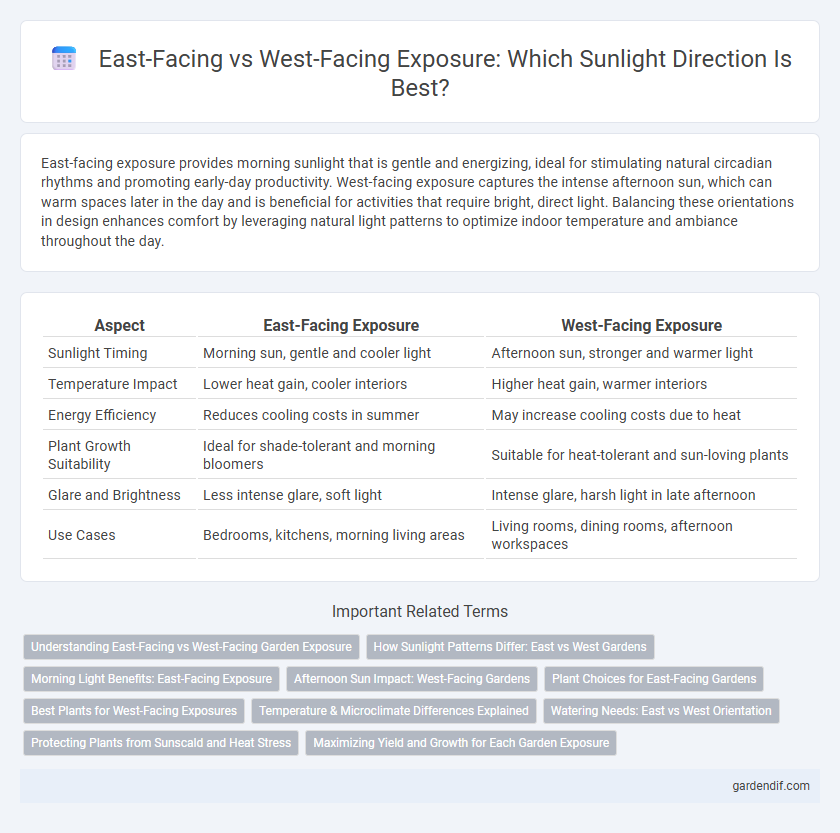
East-facing exposure vs west-facing exposure Illustration
East-facing exposure provides morning sunlight that is gentle and energizing, ideal for stimulating natural circadian rhythms and promoting early-day productivity. West-facing exposure captures the intense afternoon sun, which can warm spaces later in the day and is beneficial for activities that require bright, direct light. Balancing these orientations in design enhances comfort by leveraging natural light patterns to optimize indoor temperature and ambiance throughout the day.
Table of Comparison
| Aspect | East-Facing Exposure | West-Facing Exposure |
|---|---|---|
| Sunlight Timing | Morning sun, gentle and cooler light | Afternoon sun, stronger and warmer light |
| Temperature Impact | Lower heat gain, cooler interiors | Higher heat gain, warmer interiors |
| Energy Efficiency | Reduces cooling costs in summer | May increase cooling costs due to heat |
| Plant Growth Suitability | Ideal for shade-tolerant and morning bloomers | Suitable for heat-tolerant and sun-loving plants |
| Glare and Brightness | Less intense glare, soft light | Intense glare, harsh light in late afternoon |
| Use Cases | Bedrooms, kitchens, morning living areas | Living rooms, dining rooms, afternoon workspaces |
Understanding East-Facing vs West-Facing Garden Exposure
East-facing garden exposure receives gentle morning sunlight that supports the growth of shade-loving plants and helps conserve moisture by reducing afternoon heat stress. West-facing gardens benefit from intense afternoon sunlight, ideal for heat-tolerant plants and blooms requiring longer sun duration for optimal development. Understanding these light patterns is crucial for selecting appropriate plant species and designing efficient irrigation strategies to enhance garden health and productivity.
How Sunlight Patterns Differ: East vs West Gardens
East-facing gardens receive gentle morning sunlight that promotes the growth of shade-loving and moisture-loving plants, resulting in cooler soil temperatures and reduced evaporation. West-facing gardens experience intense afternoon sun, which increases heat stress and requires drought-tolerant, sun-loving plants to thrive. Understanding these sunlight patterns helps gardeners optimize plant selection and watering schedules for healthier, more vibrant gardens.
Morning Light Benefits: East-Facing Exposure
East-facing exposure captures abundant morning sunlight, which provides gentle, natural light ideal for waking hours and promoting productivity. Morning light from the east is rich in blue wavelengths that help regulate circadian rhythms, enhancing mood and energy levels throughout the day. This exposure minimizes intense afternoon heat, protecting indoor spaces from excessive warming and reducing cooling costs.
Afternoon Sun Impact: West-Facing Gardens
West-facing gardens receive intense afternoon sun, resulting in higher temperatures that can stress plants and increase water evaporation. This exposure favors heat-tolerant and drought-resistant species, such as lavender and succulents, that thrive in strong sunlight. Proper shading and mulching strategies optimize plant health and reduce soil moisture loss in west-facing garden environments.
Plant Choices for East-Facing Gardens
East-facing gardens receive gentle morning sunlight ideal for shade-loving and moisture-retentive plants such as ferns, hostas, and impatiens. These species thrive by avoiding harsh afternoon heat, reducing water stress and promoting lush, vibrant foliage. Selecting plants suited for east-facing exposure enhances growth, bloom longevity, and garden sustainability in partial sun conditions.
Best Plants for West-Facing Exposures
West-facing exposures receive strong afternoon sunlight, making them ideal for heat-tolerant plants such as lavender, agapanthus, and succulents like echeveria. These plants thrive in intense light and warmer temperatures, ensuring vibrant blooms and healthy foliage. For gardeners seeking sun-loving species, West-facing gardens provide optimal conditions for growth during the hottest part of the day.
Temperature & Microclimate Differences Explained
East-facing exposures receive morning sunlight, resulting in cooler temperatures and a more moderate microclimate during the day. West-facing exposures endure intense afternoon sun, causing higher temperatures and increased heat stress in their microclimates. These temperature variations significantly influence plant growth, energy use, and outdoor comfort levels.
Watering Needs: East vs West Orientation
East-facing plants receive gentle morning sunlight, reducing water evaporation and typically requiring moderate watering schedules. West-facing plants endure intense afternoon sun, increasing soil moisture loss and demanding more frequent watering to prevent drought stress. Understanding these orientation-based sunlight patterns helps optimize irrigation for healthier plant growth and water conservation.
Protecting Plants from Sunscald and Heat Stress
East-facing exposure offers morning sunlight that is less intense, reducing the risk of sunscald and heat stress on plants by providing gentle warmth and sufficient light for photosynthesis. West-facing exposure delivers harsher afternoon sun, increasing the likelihood of leaf scorch and dehydration, especially during hot summer months. Implementing shade cloth or strategic plant placement can mitigate damage in west-facing gardens by controlling heat intensity and preserving plant health.
Maximizing Yield and Growth for Each Garden Exposure
East-facing garden exposure receives gentle morning sunlight that promotes steady plant growth and reduces heat stress, ideal for leafy vegetables and herbs that thrive in cooler conditions. West-facing exposure offers intense afternoon sun and warmth, accelerating fruit ripening and maximizing yield in heat-tolerant plants such as tomatoes and peppers. Understanding plant-specific light and heat requirements enhances growth efficiency and crop production tailored to each exposure.
East-facing exposure vs west-facing exposure Infographic

 gardendif.com
gardendif.com